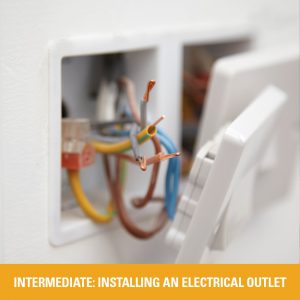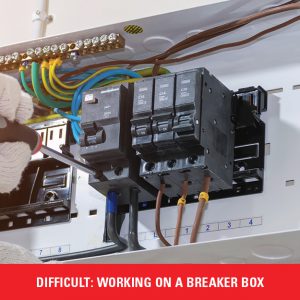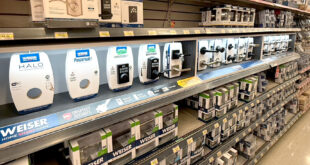Discussing home projects dealing with electricity likely puts a charge through any retailer. When helping customers tackle electrical projects, retailers should consider how difficult the project is and how a customer is planning to take it on. Some, like installing a new ceiling fan, can likely be accomplished by most homeowners with a little guidance from a knowledgeable sales associate. Other projects, like changing a breaker, need more skill and require a bit more instruction from a retailer.
Find out how employees at Weaver’s Ace Hardware in Pennsylvania help customers through common electrical projects. Across three locations, Weaver’s Ace Hardware encounters a variety of electrical projects, and approaching each question with an open mind and a strong knowledge base is essential for achieving the right results.
“Our focus is on helping our customers take care of and be comfortable in their homes,” says Ed Shenk, owner of Weaver’s Ace Hardware. “Our customer base is about 75 percent homeowner and DIYer, so we have a lot of experience working through common household projects that involve electrical work.”
The employees at Weaver’s Ace Hardware offered advice on four common electrical projects of various difficulty to share what they pay attention to when discussing electrical components with customers. While there are certain skills retailers and sales associates should be familiar with, the most important areas for retailers to focus on are customer skills and knowledge when approaching potentially hazardous projects.
When it comes to helping customers tackle potentially dangerous projects, be careful not to make suggestions that could open up your business to liability. Train employees to always recommend a professional if a customer has a question they can’t answer.
“The most important thing we do is ask good questions of our customers, Shenk says. “This really is the key to helping the customer—asking questions, listening and giving them our full attention.”
The following four projects cover some of the most common electrical issues facing DIYers looking to enhance their homes and add functionality. From a simple light fixture to changing a circuit breaker, they progress through levels of difficulty most DIYers would face.
Simple: Installing a Light Fixture or Fan

Light fixtures and ceiling fans usually come as kits, ready for assembly, making this project an entry point for a homeowner taking on electrical work.
Sales associates can suggest different products based on their first assessment of the scope of the project. How large is the room where this fixture will be installed? What are the most important product features for the customer’s goals? Is the customer capable of safely assembling the fixture and anchoring it in a ceiling? Sales associates can check with customers on their installation plans and offer suggestions, such as enlisting a helper to assist with lifting and mounting the fixture. Does the retailer offer installed sales services that can assist a customer?
A simple project like installing a fan or light is also a good entry point to introduce basic electrical safety. Associates need to be sure the customer knows that the electricity should be turned off both at the light switch and at the breaker box. Associates can also use projects like these to make sure customers have basic electrical tools and safety equipment.
A voltage tester helps the customer ensure they’re working safely, and wire cutters and strippers are necessary items when installing electrical fixtures. Other more common items customers will need include a ladder, a battery-powered drill to mount the fixture and electrical tape.
“It’s key that our associates feel equipped themselves so they can equip the customer when they’re learning about a project,” Shenk says. “We’re lucky to have many long-tenured employees in our electrical department, and they feel confident they are in the best position to help our customers.”
Assisting customers interested in installing these products also gives employees the opportunity to introduce basic electrical safety knowledge. For new homeowners or customers less accustomed to handling their own repair or installation work, stepping into this kind of project can be intimidating.
To allay these fears, Weaver’s Ace Hardware assistant store manager Glenn Keeler suggests every customer get a quick rundown of basic safety procedures associated with projects involving wiring. Does the customer know how to shut off power at the breaker panel? Can the customer identify the ground wire compared to wires carrying a current? These are questions an associate should be ready to ask, Keeler says.
“As with any project involving electricity or not, if the customer is still feeling unsure or uncomfortable, we point them toward a qualified professional,” he says.
Project Tips
- Size It Right
Not all fans and lights are created the same. A small fan designed for a hallway will do nothing to circulate air in a large living room area, just as a large fan might turn a bedroom into a wind tunnel. Associates should be trained to recommend the right fan size based on square footage and be able to guide a customer in determining the size of the space involved. - Helping Hand
Is the customer planning on attempting this installation on their own without any assistance? Any time you’re working on a ladder and with electricity, it helps to have someone to bear some of the load. If a store offers in-house handyman services or knows a local, trusted professional, this could be a good chance to suggest their services. - Shocking Reminder
Sales associates don’t always have to be selling to assist customers. For a customer working on their first electrical project, a quick reminder to check their connections can be a lifesaver. A quick primer from an associate on how to twist wires into correct connections is a great way to add value to a sale.
Intermediate: Installing an Electrical Outlet
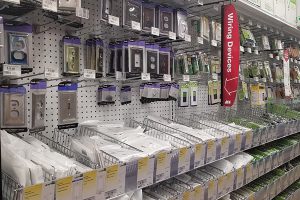
Whether a customer is trying to install a new outlet or diagnose issues with one that refuses to work, retailers can help. The basics of working with electricity still apply (make sure the breaker is turned off and the customer is using a voltage tester), but installing an outlet can involve a bit more work.
For retailers, the ability to diagnose a problem based on customer feedback is vital. Since customers do not always know what signs they are looking for, it falls to the associates to pull as much information from the customer as possible to help diagnose the issue.
“Is the outlet not working at all, or is a light flickering or going dim unexpectedly? If performance is declining, it could be a loose wire that just needs retightening, while other issues require more serious repairs,” Shenk says. “Once you have a better idea of what the customer is dealing with, you can give them better advice. This can come down to a detailed description of what they’ll see when they get home, like which wire is the ‘hot’ wire, which is neutral and which is the ground wire.”
This can extend to more detailed explanations of pre-existing wiring, such as what should be checked when detaching an old outlet before installing another.
Retailers can teach customers to recognize worn wires and how to use a wire cutter and stripper to create a new and better connection, Keeler says. This also provides an opportunity for add-on sales.
Project Tips
- New Installation
Electrical projects aren’t just about products needed to safely work with wiring and other components. Given how integrated electrical systems are in modern homes, working on an electrical outlet can be a great opportunity for sales associates to increase transactions sizes with add-on sales. A stud finder can assist customers by giving them the confidence to cut into their wall without worrying they’ll hit a stud. - New Tech
If a homeowner is installing a new outlet or updating a faulty one, it’s the perfect opportunity for sales associates to update them on new technology on the market. Smart products can connect outlets to wireless devices for remote use. Homeowners might be interested in adding components like USB charging ports to their wall outlets. - Circuit Care
Customers should be made aware of problems that could arise with outlets tied to dedicated circuits. Often, larger appliances like refrigerators and washing machines are on dedicated circuits so they can be isolated from the rest of the house when replaced or repaired.
Moderate: Installing a Smart Doorbell
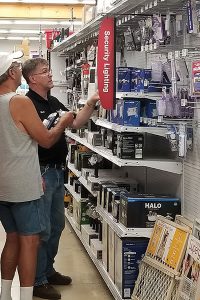
While working inside a home to add electrical products might be in many homeowners’ skillsets, working outside can be a more difficult prospect. But, with skills imparted from a skilled employee, understanding the basic installation of smart doorbells can help homeowners overcome common hassles.
One of the more significant challenges with installing items like doorbells is working with more durable building materials found on a home’s exterior. With specialized masonry tools, surfaces like brick can be conquered, but customers might not be as familiar with these tools. That’s where your team can add value and use their knowledge to shine.
Weaver’s Ace Hardware employees are trained to identify not just the tools necessary to accomplish a project to the customer’s satisfaction, but to assist in gauging how prepared customers are to take on the electrical tasks. If a customer is comfortable working on a ladder with certain tools, they can likely take on the task of setting up a camera and light above the garage door.
Other options you can recommend are battery-powered lights and doorbells. These products still require certain skills to properly mount them to exterior surfaces, but they don’t require the same electrical commitment as hardwiring a new product into a home’s existing electrical grid.
Certain products that can make these kinds of outdoor projects a bit easier include electrical tape to keep wires in place on the wall while handling the doorbell and any mounting needed.
Another tip retailers can offer with doorbells is that, unlike other electrical projects, there is no need to match specific wire colors to precise connection points.
Some other strong add-on sales relating to outdoor projects like doorbells are the special drill bits and fasteners needed to work with siding and brick exteriors. Retailers and associates can take advantage of their sales training when working on projects like smart doorbells to look beyond the primary product a customer needs and see the entire project from start to finish.
“It all starts with the right associates who are the right fit. We take time to make sure that members of the team share our mission and our desire of taking care of customers. Weaver’s helps associates maintain this level of customer experience by providing tools that allow them to be helpful, such as customer experience training, certification and retraining in areas that need to be refreshed,” Shenk says. “Our associates are equipped with the knowledge to help customers find solutions, and we feel supported by each other. An area expert is always there to answer the question or step in to help if the associate is unsure of the answer.”
Project Tips
- Prep Ahead
The homeowner should make sure the new product is charged, even if they plan to wire the doorbell into their home. This means initial installation steps can be taken care of before the product is mounted and no longer accessible. Also, the homeowner should be sure their wireless internet signal can reach wherever the new device is being installed. If it doesn’t, the homeowner needs to explore other locations or signal boosting options. - Breaker Danger
The actual wiring of a doorbell isn’t the most complex project. But, with no switch to toggle off at the installation site, it is likely a customer can forget to cut the power beforehand. That’s a shocking surprise, and one associates can be sure to caution customers against. - What’s Your Angle
While final installation on these kinds of exterior products isn’t permanent, many are constructed to be resistant to theft or tampering once completed. This means that checking on camera angles and connection speeds before the final screw is turned and wire attached is critical.
Difficult: Working on a Breaker Box

Anyone involved in home improvement retail has at some point assisted a customer and wondered if the customer truly understood the scope of the project. Maybe it was the answers the customer was giving that showed a lack of understanding of the task or the equipment the customer planned to use. No matter the cause, determining the customer’s abilities and offering the best advice possible are key areas for successful retailers and employees to shine.
As the difficulty of projects escalates, retailers and associates should rely on their training to ward against suggestions that could put their business at risk of liability. Employees should always refer a pro if the project is beyond their knowledge.
For inexperienced DIYers, opening up a breaker box can be a dangerous proposition. Some tasks, like switching off a breaker, are straightforward and necessary in order to accomplish electrical work around a home. Other tasks, such as adding a new circuit to the system, call for digging a bit deeper into a home’s electrical hub and can pose dangers.
Associates can suggest a few products as well as safety precautions customers can take when dealing with their breaker box. A rubber mat or piece of plywood to stand on when working with the box prevents the customer from being grounded. Associates can also go into detail on how most breakers are removed, Keeler says, by suggesting they grasp a breaker on the inner-center and turn it toward the outer edge. It should snap free easily.
No matter the project, retailers must emphasize to customers that electrical projects pose unique dangers and they must take caution.
“Based on the customer’s comfort level, we can go into greater detail or suggest they consult an electrician. We are not licensed electrical contractors, but we can give advice and offer a variety of solutions,” Shenk says. “Our team always works together to find a solution for customers, and if we don’t have the product they need or the knowledge to help the customer, we refer them to another business that can help.”
Project Tips
- Still Live
Properly identifying different parts of a breaker box, including the most dangerous areas to touch, is something every homeowner should be able to do if they are attempting electrical work. Retailers should make sure their associates are familiar with these components and possibly include displays or signage that can be used for instruction. Some areas of the breaker box are live even when the main breaker for the house is turned off, making those areas particularly dangerous. - Same Old, Same Old
When installing a new circuit breaker, DIYers might not know that the new circuit breaker must match the brand, make and model of the old breaker being replaced in order to fit and work properly. - A Second Opinion
Sometimes a DIYer needs an outside perspective to see that they might be out of their element on a project. Even more than electrical knowledge, employees with strong sales and customer service skills can help steer an unprepared customer toward a safer solution.
 Hardware Retailing The Industry's Source for Insights and Information
Hardware Retailing The Industry's Source for Insights and Information





